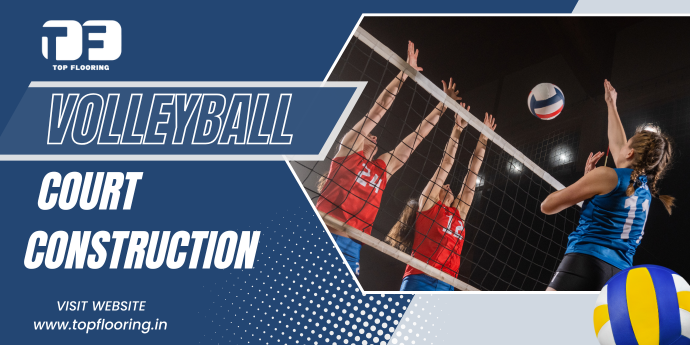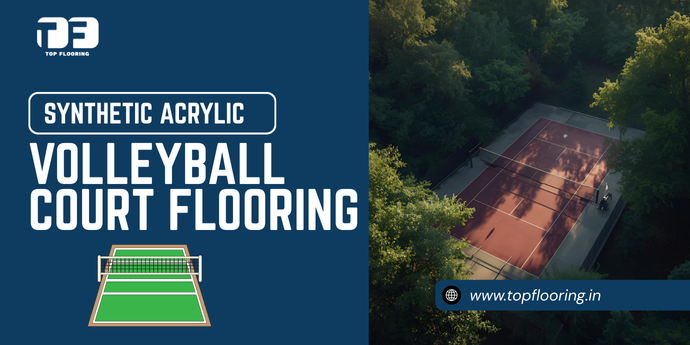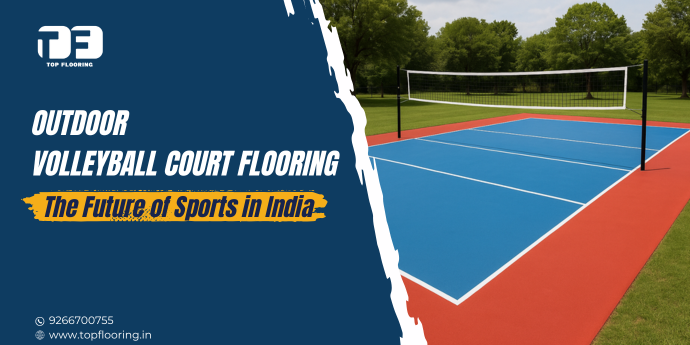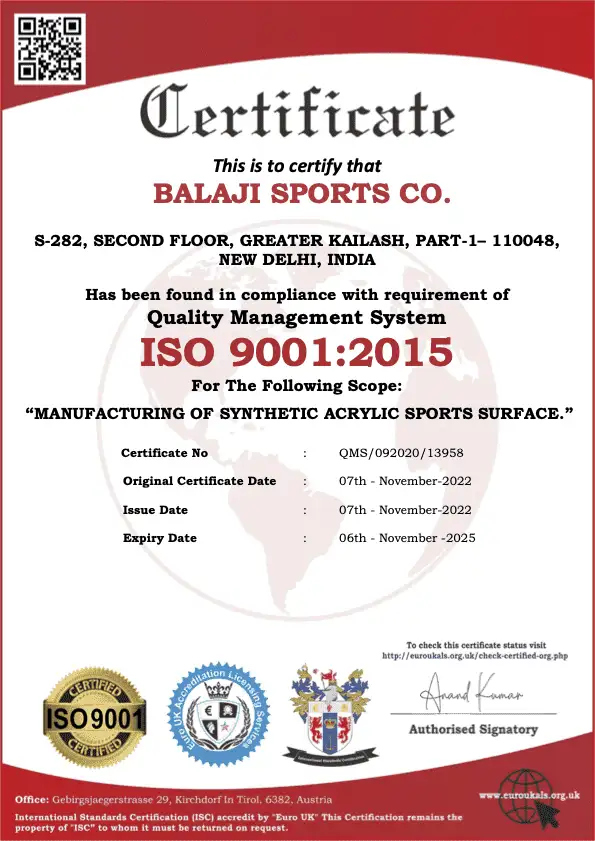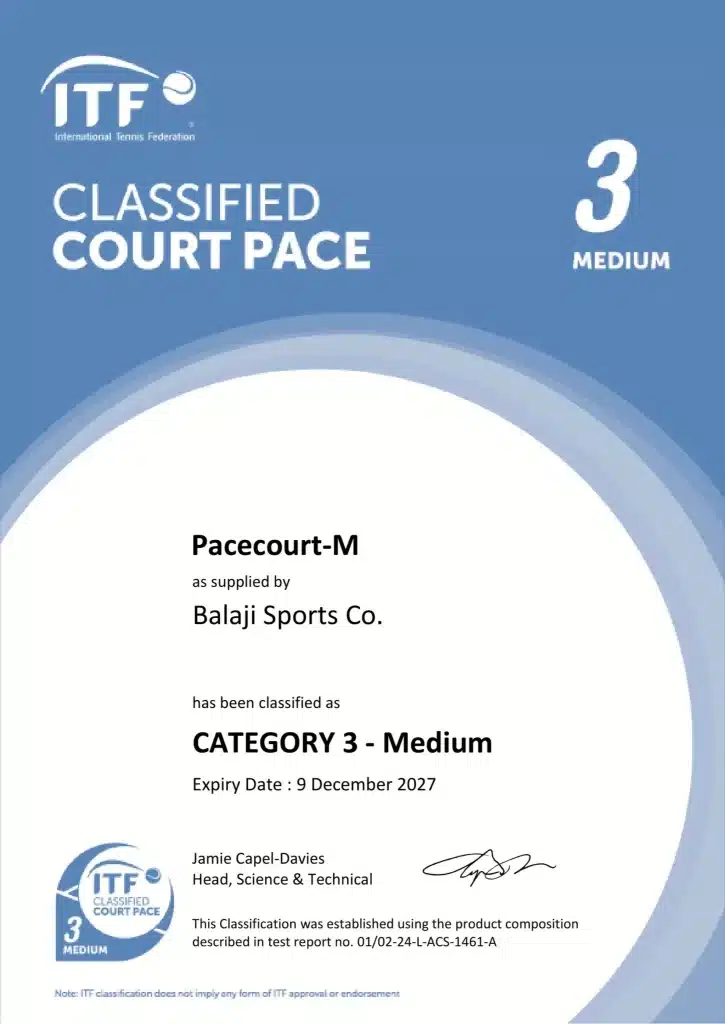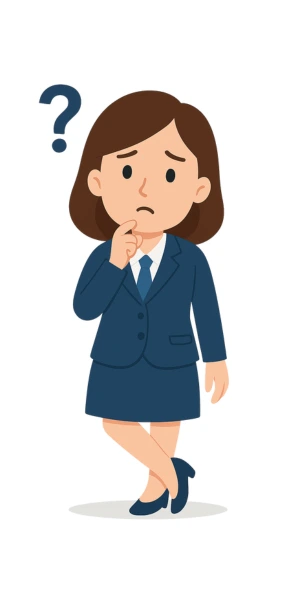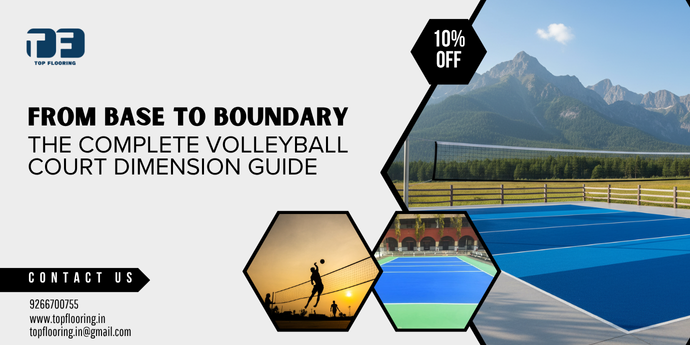
Volleyball has come a long way from being a casual beach game to one of India’s most loved and organized sports. From school tournaments and residential volleyball courts to national level championships, this fast paced sport demands precision, agility and teamwork. But beyond skill and stamina, the foundation of a great match lies in the quality and accuracy of the volleyball court itself. Every professional volleyball court has to follow global standards defined by FIVB (Fédération Internationale de Volleyball) for safety, fair play and performance consistency. The volleyball court dimensions or size, marking accuracy, net height, flooring material and surface type all determine how the game feels underfoot.
This complete guide from Top Flooring, one of India’s leading synthetic acrylic volleyball court flooring manufacturer. It covers everything from volleyball court dimensions in meters and feet to technical construction requirements, flooring layers and maintenance standards suitable for Indian climate conditions.
What is the Official Volleyball Court Size?
Volleyball Court Size in Meters
- Court Length: The court is 18m long, plenty of space for offense and defense.
- Court Width: 9m wide for 6 players per team to move, set and spike.
- Total Playing Area (with buffer): 24m × 15m buffer zone extends the playable area, player safety during dives and boundary saves.
- Free Height (Indoor Courts): Indoor courts must have at least 7m of clearance above the floor for unobstructed serves and high jumps.
- Free Zone Requirement 3m of clearance around the court for player movement, returns and defensive dives.
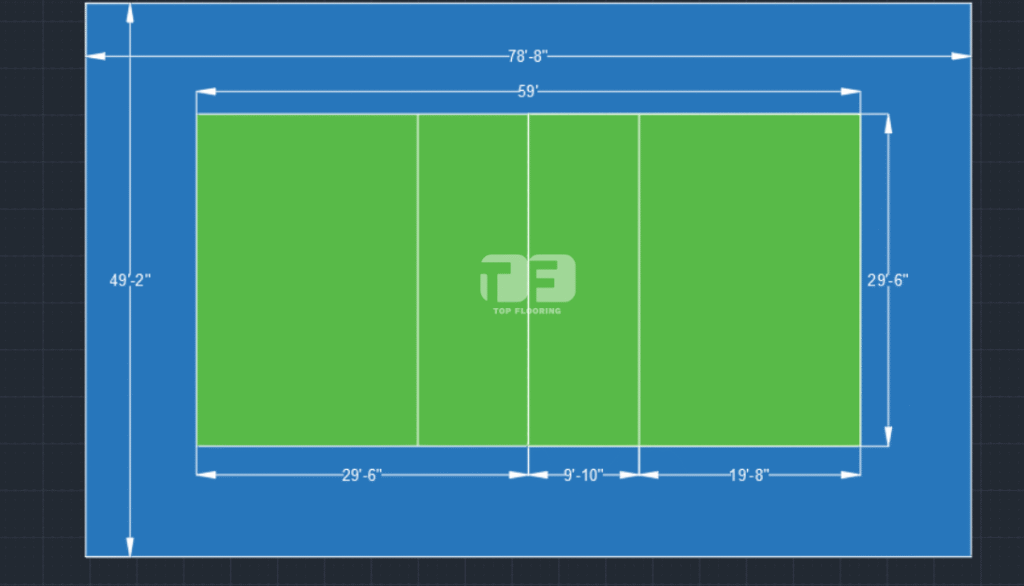
Volleyball Court Size in Feet
- Court Length: 59ft FIVB standard, consistent playing conditions in international and domestic matches.
- Court Width: 29.5ft Optimal spacing for positioning, rallies and team coordination.
- Playing Area with Clearance: 78.7ft × 49.2ft, Includes the mandatory safety zone, space for players to chase and recover balls beyond the lines.
- Ceiling Height (Indoor): Minimum 23ft, Prevents interference from ceilings, lights or beams, fair play in indoor environments.
- Uniform Dimensions for All Levels: Same for men and women, only the net height varies between categories.
Top Flooring Insight: A levelled base built to FIVB specifications ensures a consistent ball bounce, accurate line markings and fair play in every match.
Volleyball Court Layout & The All-Important Markings
At first glance a volleyball court may look pretty straightforward. But scratch beneath the surface and you’ll see that every single line on it has a vital role to play. Quality is key when it comes to those lines. Which is exactly why we recommend high-quality acrylic line paint. You get long-lasting visibility, precision, and a safe surface for both pros and amateur players.
Boundary Lines
You’re not going to miss the 5 cm (2 inch) wide boundary lines, which are painted on with contrasting, non-slip acrylic paint for maximum clarity. The inner edge of these lines defines the court’s playable area, helping officials make fair calls every single match.
The Center Line
The center line splits the court neatly in two, each section measuring 9 meters x 9 meters. It runs directly under the net, keeping both teams well separate and the court layout looking tidy.
Attack Line (3-Meter Line)
The attack line is a crucial boundary that divides front and back row play. It’s 3 meters from the centre line on both sides, and a pretty important rule to remember: back row players aren’t allowed to spike the ball from in front of this line – it helps keep the game balanced.
Service Zone – Where the Action Starts
Behind each end line you’ll find the service zone – a 9-meter-wide area where players need to serve from. This rule keeps things consistent and fair throughout each rally.
Subs and Liberos – Managing Player Rotations & Substitutions
The zones marked outside the sidelines help manage player rotations and subs, keeping the game moving smoothly and keeping everyone in the right positions.
Tip from us at Top Flooring: Don’t forget to use UV-stable white acrylic line marking paint when painting your court. It won’t fade in the sun or under the floodlights. Keeping your court looking crisp and game-ready all year round.
Net System, Height & Accessories
The volleyball net is providing the essential fair play and precision you need for every serve and spike. The net’s height, width and pole placement are all standardised for men’s and women’s games in order to ensure fair play and keep the competition levelled.
| Category | Net Height | Net Width | Post Distance |
| Men’s Matches | 2.43 m (7 ft 11 5/8 in) | 1 m | 10 m apart |
| Women’s Matches | 2.24 m (7 ft 4 1/4 in) | 1 m | 10 m apart |
Poles:
The poles are set roughly 0.5 -1 meter away from the sidelines – giving the players loads of room to move and hopefully stopping them from bashing into the posts during play. Durable poles keep the net tight and kept the court safe and looking like a pro’s court
Mesh:
The mesh on the net is made up of 10cm squares. Which gives you a clear view of what’s going on while still letting the players get a good grip on the ball during rallies. This kind of mesh size stops the ball going through which keeps the game fair and consistent.
Material:
The net is made out of top quality nylon or high-density poly ethylene (HDPE) – and that gives you exceptional strength, weather resistance and flexibility. These materials keep the net tight and in good nick even when it’s being used outdoors.
Top Cable:
You’ll often see a steel wire going through the top of the net. It’s about 9.5 -10 m long and makes sure the net is nice and tight all the way along. This stops the net sagging and means the ball bounces back off the net just right.
Side Bands:
There are some vertical white bands along the edges of the net. These bands mark the official playing area on the court – and they help the referees and players figure out whether the ball has landed in or out.
Top Flooring Suggestion:
If you’re planning to put the net outdoors then Top Flooring recommend you use powder-coated galvanised posts with some anchored sleeves. This setup will keep it stable, prevent it rusting and look great for years to come.
Indoor vs Outdoor Volleyball Court Dimensions
The official size of a volleyball court is still 18 meters long and 9 meters wide. Whether you’re playing indoors or out, but the specifics are where things get really different.
| Feature | Indoor Court | Outdoor Court |
| Surface Type | Indoor courts are usually covered in wood or synthetic flooring that been treated to be smooth and shock-absorbent. | Outdoor volleyball courts have a tougher job – they have to withstand heat, rain and UV rays while still giving players a good grip and bounce. |
| Free Zone | Indoor courts need a clear space of at least 3 meters. | Outdoor courts need an even bigger clear space 5 meters or more just to keep everyone safe. |
| Lighting | Indoor courts rely on artificial lighting which is around 300-500 lux. | They use a combination of natural light and floodlights to make sure they’ve got enough light to play. |
| Weather Exposure | Indoor courts are completely protected from the elements no sun, rain or wind to have to deal with. | Outdoor courts on the other hand are designed to withstand the weather, including UV exposure, rain and temperature fluctuations. |
| Maintenance Needs | Indoor courts need a lot of keeping up, including polishing and upkeep to keep them looking good and feeling good underfoot. | Outdoor courts are a lot easier to look after just a quick clean and a fresh coat of paint now and then should keep them going. |
| Ideal Choice | If you’re looking for a top-of-the-range indoor court then you really can’t go past stadiums, indoor arenas and sports halls. | Outdoor courts are perfect for space from schools and housing complexes to clubs and public parks. |
Best Volleyball Court Flooring Materials
The flooring chosen plays a big role in player comfort, safety and performance. Each material has its own pros and cons based on the environment and usage.
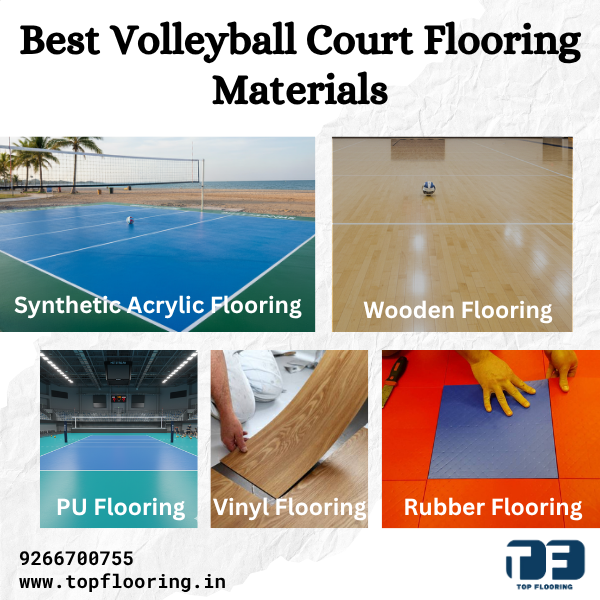
Synthetic Acrylic Flooring (Top Flooring Specialty)
Multi layer cushioned surface system with 5 to 8 layers designed for best playability and shock absorption. Excellent slip resistance and weatherproof durability, suitable for outdoor courts. UV resistant coatings, colors remain bright and fade proof even under intense sun. Low maintenance, long term cost effective. Preferred by schools, colleges, sports complexes and residential parks for reliable and durable court surfaces.
Wooden Flooring
Wooden flooring provides natural rebound and elasticity which is good for player comfort and reduces joint stress during play. But requires controlled humidity and regular polishing to maintain surface integrity and shine. Since India has varied climate, wooden surfaces face challenges like warping or cracking during monsoons and hence not practical and expensive for long term use in outdoor or humid regions.
PU, Vinyl & Rubber Flooring
These materials provide good cushioning and flexibility, suitable for indoor or multi sport facilities. But provides less surface grip, especially in outdoor conditions where weather variations affect traction. Performs well in closed environment but lacks all weather resilience of acrylic flooring.
Top Flooring Verdict: Synthetic acrylic flooring is the most balanced option, best grip, consistent bounce and long lasting resilience. Ensures player safety and performance, hence the most practical and cost effective option for volleyball court construction in India.
Building a Solid Foundation – Base Construction & Acrylic Layer System
A solid foundation and correct layering system are the key to a long-lasting court that can withstand years of heavy use.
Building a Strong Base
- Material – Concrete (M20 grade) or Asphalt: Generally the base of the court is built with M20-grade concrete or high-quality asphalt – both provide the required strength and stability to support the acrylic coating system.
- Thickness – 100-150 mm Reinforced: A base thickness of 100-150 mm gives you the load-bearing capacity you need, and prevents cracks or uneven settlement – even under heavy use and varying weather conditions.
- The Slope – 1:100 for Water Drainage: A gentle slope of 1:100 makes sure rainwater drains off the surface without pooling, and that the court dries quickly.
- Expansion Joints – Every 4.5-6 meters (for concrete bases): We include expansion joints every 4.5-6 meters in concrete bases to stop thermal cracking and to let the court expand and contract with the temperature.
A Professional 8-Layer System for Your Top Flooring
Top Flooring uses a 8-layer professional acrylic system that’s designed to give you consistent bounce, traction, and player comfort. Each layer is there to enhance the durability and performance of the court.
- Concrete Primer: This first layer helps the acrylic coatings stick properly to the concrete surface, so it doesn’t peel off over time.
- Acrylic Resurfacer (1 Layer): This layer fills in any pores and minor imperfections in the base, creating a smooth surface that’s perfect for the next layers.
- Cushion Coat (5 Layers): These rubberized layers add some much-needed elasticity and impact absorption, to reduce stress on players’ joints while making the court feel great to play on.
- Color Coat (2 Layers): The final color finish gives the court a non-slip surface that’s UV-resistant, and can withstand intense sunlight and heavy use – while still looking great.
- Silica Sand Mixture: We mix some silica sand in with the coating to give it better grip and traction – so you can move quickly and safely.
- Line Marking: We apply the lines precisely using white acrylic paint, to define the play boundaries and keep them clear and visible under all lighting conditions.
What You Get with Top Flooring: Every layer is made to the highest quality standards, so you get unmatched performance, consistent adhesion, and weather resistance that can handle the Indian climate. That means a court that stays smooth, safe, and looks great for years of continuous play.
Court Surroundings, Safety Zones & Lighting
Free Zone
Having at least 3 meters of clear space around the playing area gives players the room. They need to make those tricky dives, get back to the action, without worrying about running into something.
When you’re building an outdoor court, try shooting for 5 meters or more of clearance. If you can – you never know when someone’s going to make a desperate lunge for the ball & end up crashing into the fence.
Fencing
A good rule of thumb for court fencing is to go 10-12 ft high, to keep the ball safely contained and prevent any interruptions to the game. And by the way, using some powder-coated steel fencing is a no-brainer – it lasts longer & resists rust a lot better than other materials, even when you’re playing in rough conditions.
Lighting
Indoor courts need to have a consistent level of brightness (around 300-500 lux) to keep the playing surface nice & clear, and to reduce those annoying shadows that make it hard to see what’s going on.
Outdoor set-ups are a bit of a different story, though – they need about 200-400 lux worth of light. And the best way to get it is usually by installing some floodlights up high (around 9-12 meters) with some anti-glare fixtures to keep the glare to a minimum.
Drainage
Outdoor courts need to have a bit of a slope (1:100 to be exact) to make sure any rainwater runs off into the side channels & doesn’t just pool up on the surface.
And while you’re at it, consider going with a matte-finish color for your court. It’ll keep the glare down & make it easier for players to see what they’re doing, even under bright lights.
Volleyball Court Construction Cost in India
| Court Type | Area (sq ft) | Approx. Cost (₹) | Surface Type | Ideal Use |
| Indoor Wooden | 4,800 | ₹6–₹8 lakh | Teak / Maple | ProfessionalAcademies |
| Outdoor Acrylic | 5,000 | ₹3.5–₹5.5 lakh | Synthetic Acrylic | Schools / Parks |
| Multipurpose Combo | 5,500 | ₹4–₹6 lakh | Acrylic + PU | Clubs / Communities |
Top Flooring Insight: Synthetic acrylic volleyball courts are 40% more cost-efficient and last twice as long as traditional wooden systems when maintained correctly.
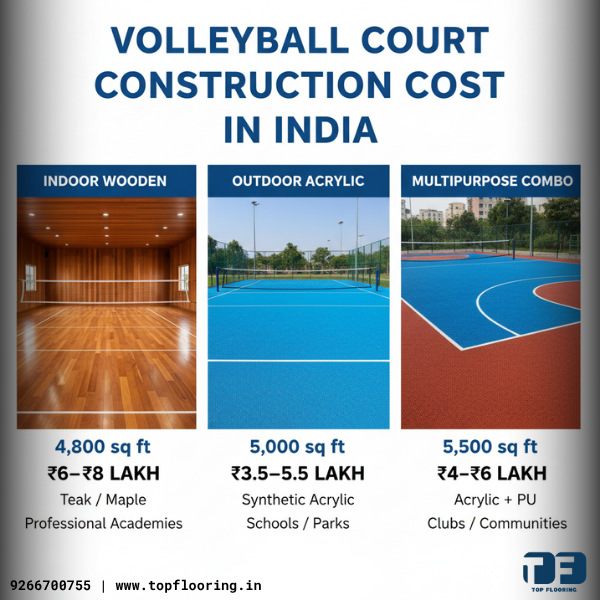
Maintenance & Resurfacing Schedule – Keeping Your Court in Top Condition
Routine Maintenance
Keep your court looking its best. A soft brush or mild detergent wash should be done once a week to stop dirt from building up and to keep the court safe and grippy. Try to avoid dragging heavy stuff like benches or poles across the court. Those can easily cause nasty scratches and tears that’ll affect gameplay. Giving the court a good rinse every now and then will keep the floor looking its best. And prevent dust and other tiny debris from building up. You should also make sure to touch up the lines every 3-4 years depending on how much the court is used and how much sun it gets.
Volleyball Court Resurfacing
Most acrylic sports floors will need a resurface every 5-6 years, but if you’re pushing the court hard or the weather’s been really tough on it then it may need doing more often. At Top Flooring we supply all the top-quality recoating materials you’ll need – and they’re designed to blend in seamlessly with what you already have, so you don’t need to rip the whole thing up.
Average Maintenance Cost of Volleyball Court
We’re happy to report that the average annual maintenance cost of volleyball court is a pretty reasonable ₹10-₹15 per sq. ft – that’s a lot less than what you’d pay for a wooden or PU surface. What really sets Top Flooring apart though is our eco-friendly, low-VOC acrylic compounds – they’re super easy to recoat, sustainable, and long-lasting, so you can save money on future renovations.
The Top Flooring Advantage: Because we use eco-friendly, low-VOC acrylic compounds that are super easy to recoat, without needing to rip out the old stuff first.
Common Mistakes to Watch Out For on the Job Site During Construction
The Wrong Base Slope
A badly conceived slope is just begging for trouble. Water’s gonna find its way to the surface and sit there, messing up the whole court and leaving it pretty much unplayable for days after a rain fall even. But a base with a 1% slope is gonna let that water just run right off – no problem.
Not Using Concrete Primer
If you apply on some paint without bothering to prime it first. Primer acts as this great middleman between the base and your acrylic coatings. Which allowing all the layers to stick together and last a long time.
Started on an Uneven Base Finishing Job
With an uneven base, you can just forget about having a perfectly even ball bounce and surface. We’re talking about surface irregularities galore here. So basically, to keep things smooth and even, do a good job of finishing that base – make it level and all that jazz.
Get the Right Paint Type
Don’t even think about using some low-grade or non-acrylic paint. It’s going to reduce surface grip and have zero UV resistance. Premium acrylic materials offer proper traction, colors won’t fade.
Improper Net Alignment
If your net is off the game just isn’t going to be as fair. Properly align the net, make sure it’s anchored right, just like the FIVB standards say, and you’re all set.
Pay Attention to Drainage
And finally, water pooling beneath the court is going to weaken whole foundation. Make sure you have proper drainage set up and you’ll keep that court running like clockwork for years to come.
Certified Materials
Anytime you are shopping for materials, always go with FIVB and ISO-certified and from a supplier you’ve come to trust like Top Flooring to get the most out of your investment. The performance, durability and the minimal maintenance will be with you a long time.
Engineering-Detailed (Technical Section)
This bit of the manual is going to give you the detailed technical lowdown that your average sports court construction project needs to know about – useful for anyone who’s plugging away on the construction, consultancy or architectural end of things.
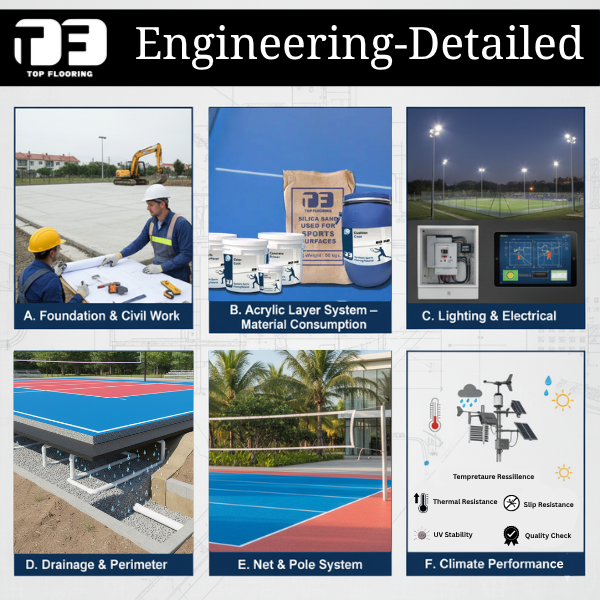
Foundation & Civil Work
- Concrete Mix:
We reckon an M20 grade or higher is what you should be going for here that’s the minimum requirement to get the sort of compressive strength and structural stability you need for a sports flooring job to turn out right. - Thickness:
You’re looking at a minimum base slab thickness of 125 mm here and you’re going to need 8 mm rebar mesh spaced about 150 mm apart to make sure it can withstand the rigours of being a sports floor and still looks pretty. - Slope:
The court surface should slop down at a gentle rate aim for 1:100 to 1:120 to get the water to run off in a logical way and not build up pools on the surface. - Surface Finish:
Last but not least the finish steel trowel smooth is what you’re aiming for nothing too bumpy or undulating here and this means no surface irregularities of more than 3 mm if you’re laying a straightedge over a 3 meter length.
Acrylic Layer System – Material Consumption
| Layer | Product | Avg. Thickness | Consumption Rate |
| 1 | Concrete Primer | 0.08 mm | 0.1–0.15 kg/m² |
| 2 | Acrylic Resurfacer (1 layer) | 0.2 mm | 0.3–0.5 kg/m² |
| 3 | Cushion Coat (5 layers) | 1.5 mm | 1.0–1.2 kg/m² |
| 4 | Color Coat (2 layers) | 0.4 mm | 0.35–0.5 kg/m² |
| 5 | Line Marking | 0.1 mm | 0.05 kg/m² |
Total System Thickness: ~2.2–2.5 mm (for cushioned systems)
Lighting & Electrical
- Illumination Level:
Lighting should be uniform at 300–500 lux for clear visibility and optimal play during evening matches or low light conditions. - Pole Height:
Poles should be 9-12 meters high for balanced lighting across the court without harsh shadows or glare. - Fixture Type:
Energy efficient LED floodlights with IP65 rating are ideal, long lasting, weather resistant and consistent performance in outdoor. - Mounting Angle:
Fixtures should be installed at 25-30° angle to get uniform light distribution and reduce glare for players and spectators.
Drainage & Perimeter
- Perimeter Gutter Depth:
150 mm deep perimeter gutter to collect surface water and direct it to drainage points around the court. - Outlet Slope:
Drainage outlet should have a minimum slope of 1:80 to ensure smooth flow of water and no water stagnation that can damage the surface or foundation. - Pipe Diameter:
PVC pipes of 100 mm diameter should be used for drainage lines to handle heavy water flow during monsoon or cleaning.
Net & Pole System
- Pole Material:
Posts should be hot dip galvanized steel of 75 mm outer diameter for corrosion resistance and long term structural reliability. - Embedded Sleeve Depth:
Each pole should be embedded in 600 mm deep embedded sleeve filled with concrete grouting for maximum stability during play. - Net Tension Mechanism:
Worm gear or pulley based net tensioning system for professional level play. - Guy Rope Anchor:
Optional guy rope anchors for temporary installation or portable court for structural integrity under load.
Climate Performance
- Thermal Resistance:
Acrylic coatings are designed to withstand thermal variation of 60°C for performance under extreme Indian summer. - UV Stability:
All coatings are UV tested for 2000 hours under ASTM G154 standards for long term color retention and surface durability against sunlight. - Slip Resistance:
Court surface has slip resistance coefficient more than 0.6 (dry) as per ASTM E303 for safe traction and reduce player injury. - Top Flooring Quality Check:
Every batch of Top Flooring acrylic material is tested for adhesion, viscosity and flexibility under ISO 9001 certified process to ensure performance on every installation.
Top Flooring Quality Check: Tested for adhesion, viscosity and flexibility under ISO 9001 process.
Conclusion
A volleyball court that meets global standards requires precision, right materials and expert guidance. A measured court ensures fair play; a layered surface ensures long term safety and performance. With Top Flooring’s certified synthetic acrylic systems, every layer from primer to final color coat is designed for India’s climate and built to FIVB standards. Whether for schools, private clubs or professional arenas, these surfaces offer unmatched durability, bounce and comfort.
Frequently Asked Questions
The volleyball court size18 is meters long and 9 meters wide with 3 meters free zone around all sides.
The volleyball court size is 59 feet × 29.5 feet with at least 9.8 feet of clearance beyond each boundary.
Synthetic acrylic flooring by Top Flooring is UV resistant, weatherproof and easy to maintain.
Synthetic volleyball court is 4-7 years depending on usage and maintenance.
Yes, with Top Flooring’s all-weather acrylic systems, outdoor volleyball courts can perform flawlessly year round.
At least 24 m × 15 m (78.7 ft × 49.2 ft) including buffer zones.

